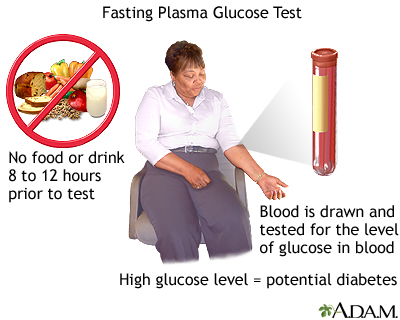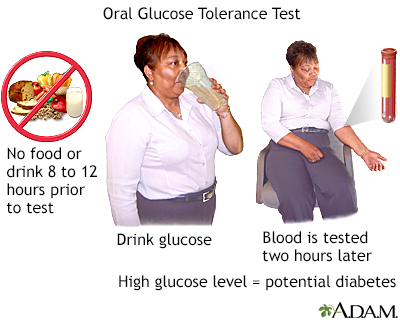Glucose tolerance test - non-pregnant
Oral glucose tolerance test - non-pregnant; OGTT - non-pregnant; Diabetes - glucose tolerance test; Diabetic - glucose tolerance test
The glucose tolerance test is a lab test to check how your body moves sugar from the blood into tissues like muscle and fat. The test is often used to diagnose diabetes.
Tests to screen for diabetes during pregnancy are similar, but are done differently.
Images


I Would Like to Learn About:
How the Test is Performed
The most common glucose tolerance test is the oral glucose tolerance test (OGTT).
Before the test begins, when you have had nothing to eat or drink for at least 8 hours, a sample of blood will be taken.
You will then be asked to drink a liquid containing a certain amount of glucose (usually 75 grams). Your blood will be taken again every 30 to 60 minutes after you drink the solution.
The test may take up to 3 hours.
A similar test is the intravenous (IV) glucose tolerance test (IGTT). It is rarely used, and is never used to diagnose diabetes. In one version of the IGTT, glucose is injected into your vein for 3 minutes. Blood insulin levels are measured before the injection, and again at 1 and 3 minutes after the injection. The timing may vary. This IGTT is almost always used for research purposes only.
A similar test is used in the diagnosis of growth hormone excess (acromegaly) when both glucose and growth hormone are measured after the glucose drink is consumed.
How to Prepare for the Test
Make sure you eat normally for several days before the test.
Do not eat or drink anything for at least 8 hours before the test. You cannot eat during the test.
Ask your health care provider if any of the medicines you take can affect the test results.
How the Test will Feel
Drinking the glucose solution is similar to drinking very sweet soda.
Serious side effects from this test are very uncommon. With the blood test, some people feel nauseated, sweaty, lightheaded, or may even feel short of breath or faint after drinking the glucose. Tell your provider if you have a history of these symptoms related to blood tests or medical procedures.
When the needle is inserted to draw blood, some people feel moderate pain. Others feel only a prick or stinging. Afterward, there may be some throbbing or a slight bruise. This soon goes away.
Why the Test is Performed
Glucose is the sugar the body uses for energy. People with untreated diabetes have high blood glucose levels.
Most often, the first tests used to diagnose diabetes in people who are not pregnant are:
- Fasting blood glucose level: diabetes is diagnosed if it is 126 mg/dL (7 mmol/L) or higher, on 2 different tests, done when in a person is in their usual state of health
- Hemoglobin A1C test: diabetes is diagnosed if the test result is 6.5% or higher
Glucose tolerance tests are also used to diagnose diabetes. The OGTT is used to check for or diagnose diabetes in people with a fasting blood glucose level that is high, but is not high enough (at or above 126 mg/dL or 7 mmol/L) to meet the diagnosis for diabetes.
Abnormal glucose tolerance (blood sugar goes too high during the glucose challenge) is an earlier sign of diabetes than an abnormal fasting glucose.
Normal Results
Normal blood values for a 75 gram OGTT used to check for type 2 diabetes in those who are not pregnant:
Fasting -- 60 to 99 mg/dL (3.3 to 5.5 mmol/L)
1 hour -- Less than 200 mg/dL (11.1 mmol/L)
2 hours -- This value is used to make the diagnosis of diabetes.
- Less than 140 mg/dL (7.8 mmol/L) is normal
- From 140 mg/dL to 199 mg/dL (7.8 to 11.1 mmol/L) is considered impaired glucose tolerance
- A level of 200 mg/dL (11.1mmol/L) or higher is diagnostic of diabetes
The examples above are common measurements for results of these tests. Normal value ranges may vary slightly among different lab. Some labs use different measurements or test different samples. Talk to your provider about the meaning of your specific test results.
What Abnormal Results Mean
A glucose level that is higher than normal may mean you have pre-diabetes or diabetes:
- A 2-hour value of 140 to 199 mg/dL (7.8 and 11.1 mmol/L) is called impaired glucose tolerance. Your provider may call this pre-diabetes. It means you are at increased risk of developing diabetes over time.
- Any glucose level of 200 mg/dL (11.1 mmol/L) or higher means you have diabetes.
Serious stress to the body, such as from trauma, stroke, heart attack, or surgery, can raise your blood glucose level. Vigorous exercise can lower your blood glucose level over hours but may immediately increase blood glucose.
Some medicines can raise or lower your blood glucose level. Before having the test, tell your provider about any medicines you are taking.
Risks
You may have some of the symptoms listed above under the heading titled "How the Test will Feel."
There is little risk involved with having your blood taken. Veins and arteries vary in size from one person to another and from one side of the body to the other. Taking blood from some people may be more difficult than from others.
Other risks associated with having blood drawn are slight, but may include:
- Excessive bleeding
- Multiple punctures to locate veins
- Fainting or feeling lightheaded
- Hematoma (blood buildup under the skin)
- Infection (a slight risk any time the skin is broken)
Related Information
DiabetesGestational diabetes
Cushing syndrome
References
American Diabetes Association Professional Practice Committee. 2. Diagnosis and classification of diabetes: standards of care in diabetes - 2025. Diabetes Care. 2025;48(Supplement_1):S27-S49. PMID: 39651986 pubmed.ncbi.nlm.nih.gov/39651986/.
Mojica A, Weinstock RS. Carbohydrates. In: McPherson RA, Pincus MR, eds. Henry's Clinical Diagnosis and Management by Laboratory Methods. 24th ed. Philadelphia, PA: Elsevier; 2022:chap 17.
Sacks DB. Diabetes mellitus. In: Rifai N, Chiu RWK, Young I, Burnham CAD, Wittwer CT, eds. Tietz Textbook of Laboratory Medicine. 7th ed. Philadelphia, PA: Elsevier; 2023:chap 47.
BACK TO TOPReview Date: 2/10/2025
Reviewed By: Sandeep K. Dhaliwal, MD, board-certified in Diabetes, Endocrinology, and Metabolism, Springfield, VA. Also reviewed by David C. Dugdale, MD, Medical Director, Brenda Conaway, Editorial Director, and the A.D.A.M. Editorial team.

Health Content Provider
06/01/2025
|
A.D.A.M., Inc. is accredited by URAC, for Health Content Provider (www.urac.org). URAC's accreditation program is an independent audit to verify that A.D.A.M. follows rigorous standards of quality and accountability. A.D.A.M. is among the first to achieve this important distinction for online health information and services. Learn more about A.D.A.M.'s editorial policy, editorial process and privacy policy. A.D.A.M. is also a founding member of Hi-Ethics. This site complied with the HONcode standard for trustworthy health information from 1995 to 2022, after which HON (Health On the Net, a not-for-profit organization that promoted transparent and reliable health information online) was discontinued. |
The information provided herein should not be used during any medical emergency or for the diagnosis or treatment of any medical condition. A licensed medical professional should be consulted for diagnosis and treatment of any and all medical conditions. Links to other sites are provided for information only -- they do not constitute endorsements of those other sites. © 1997- 2025 A.D.A.M., a business unit of Ebix, Inc. Any duplication or distribution of the information contained herein is strictly prohibited.
